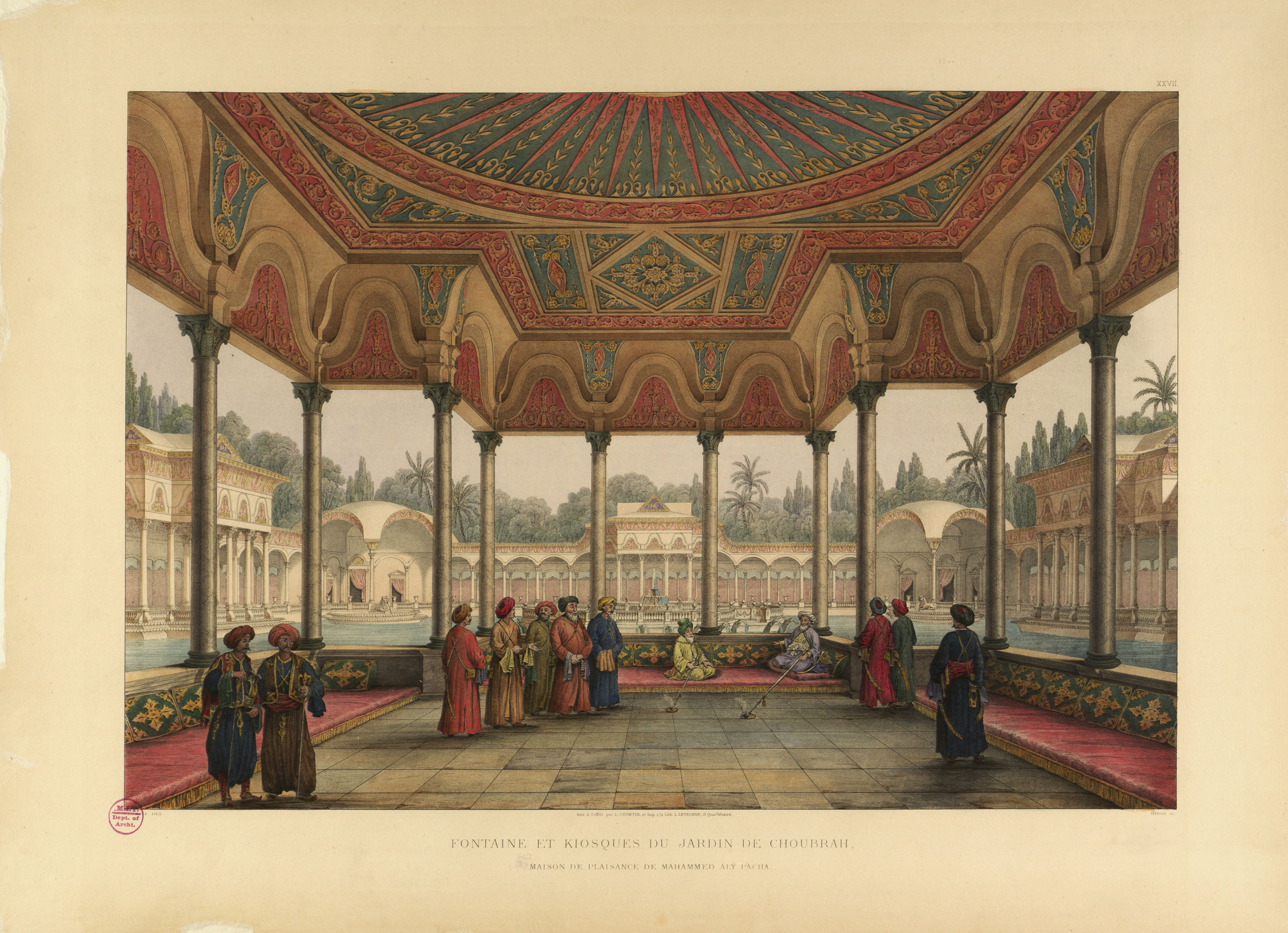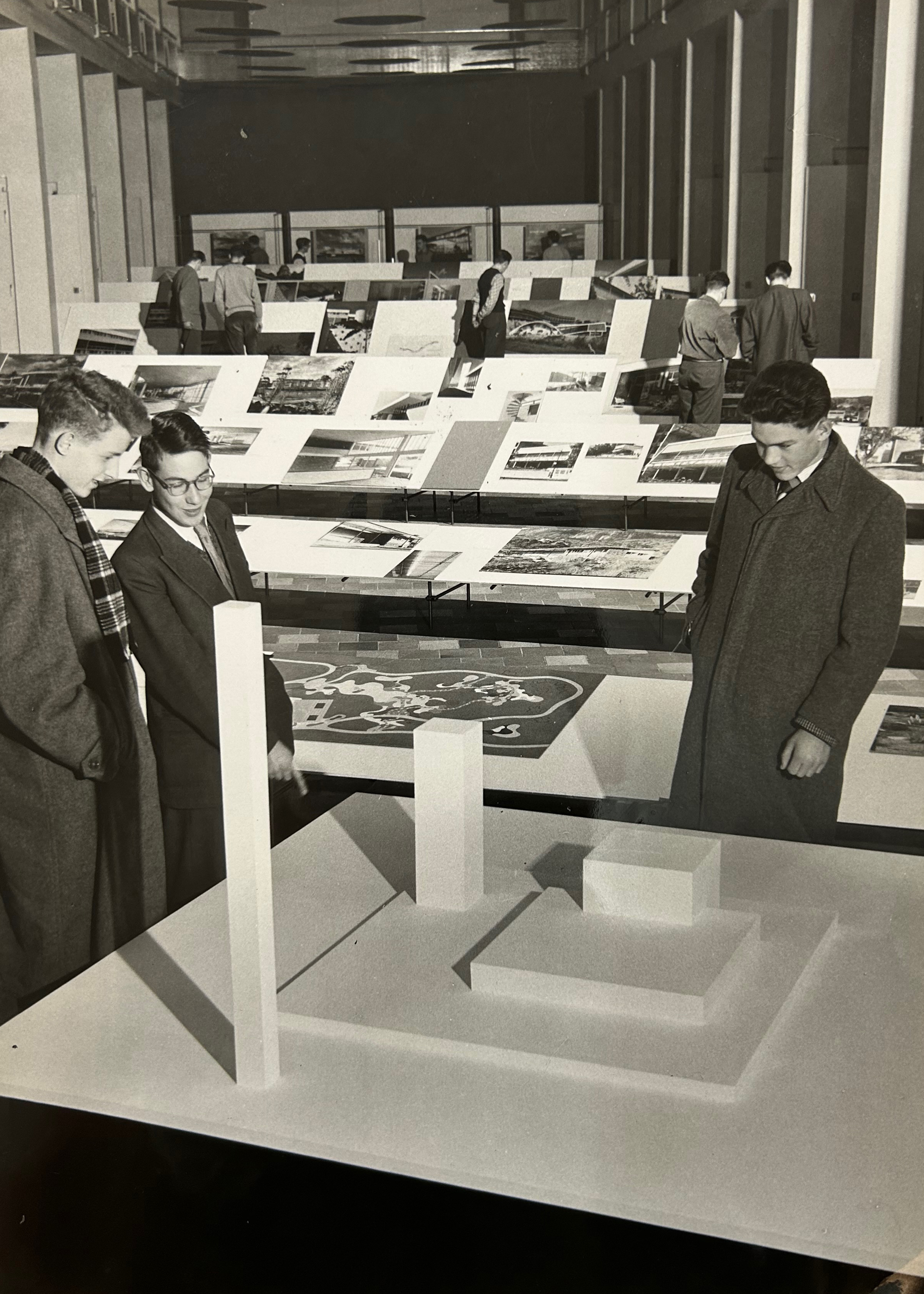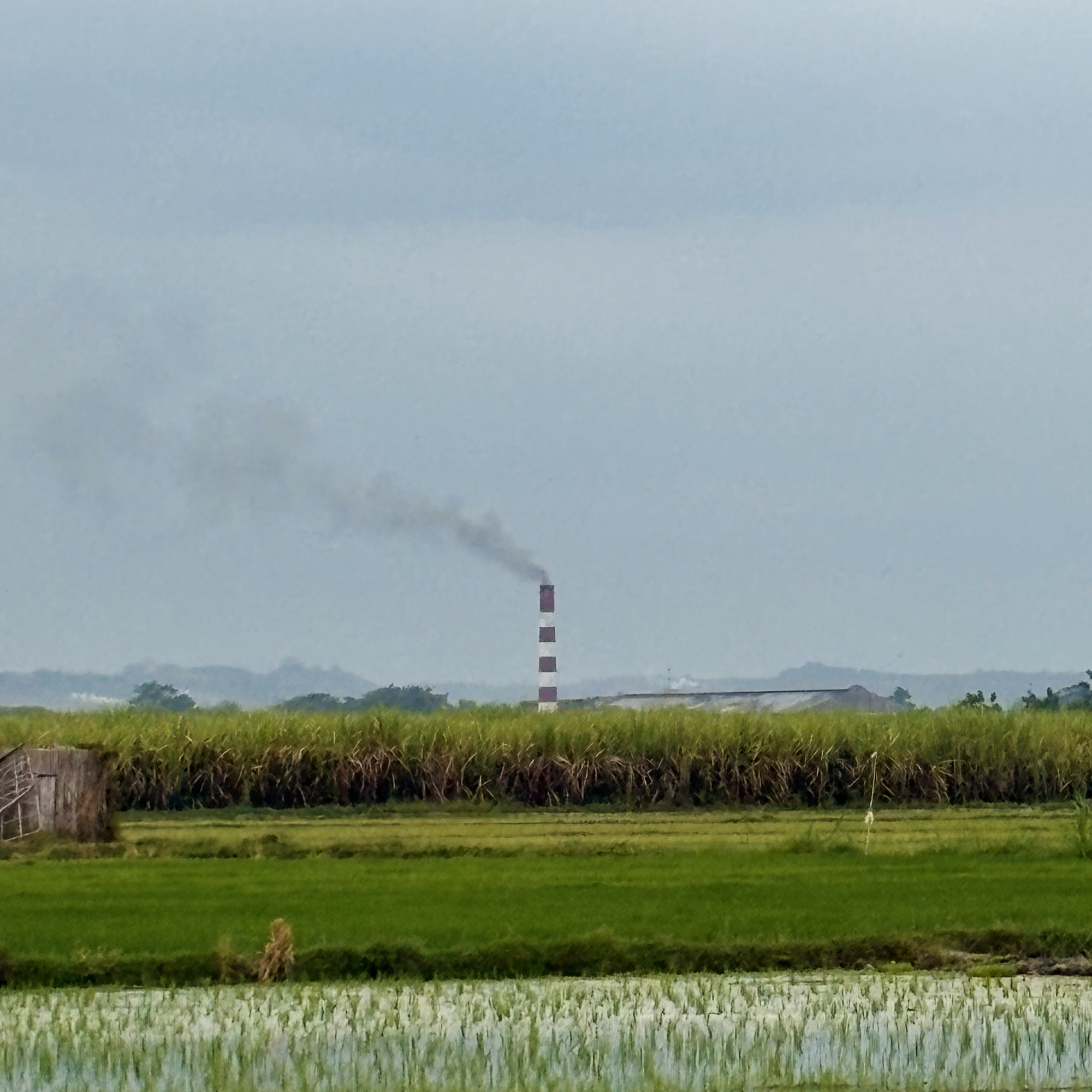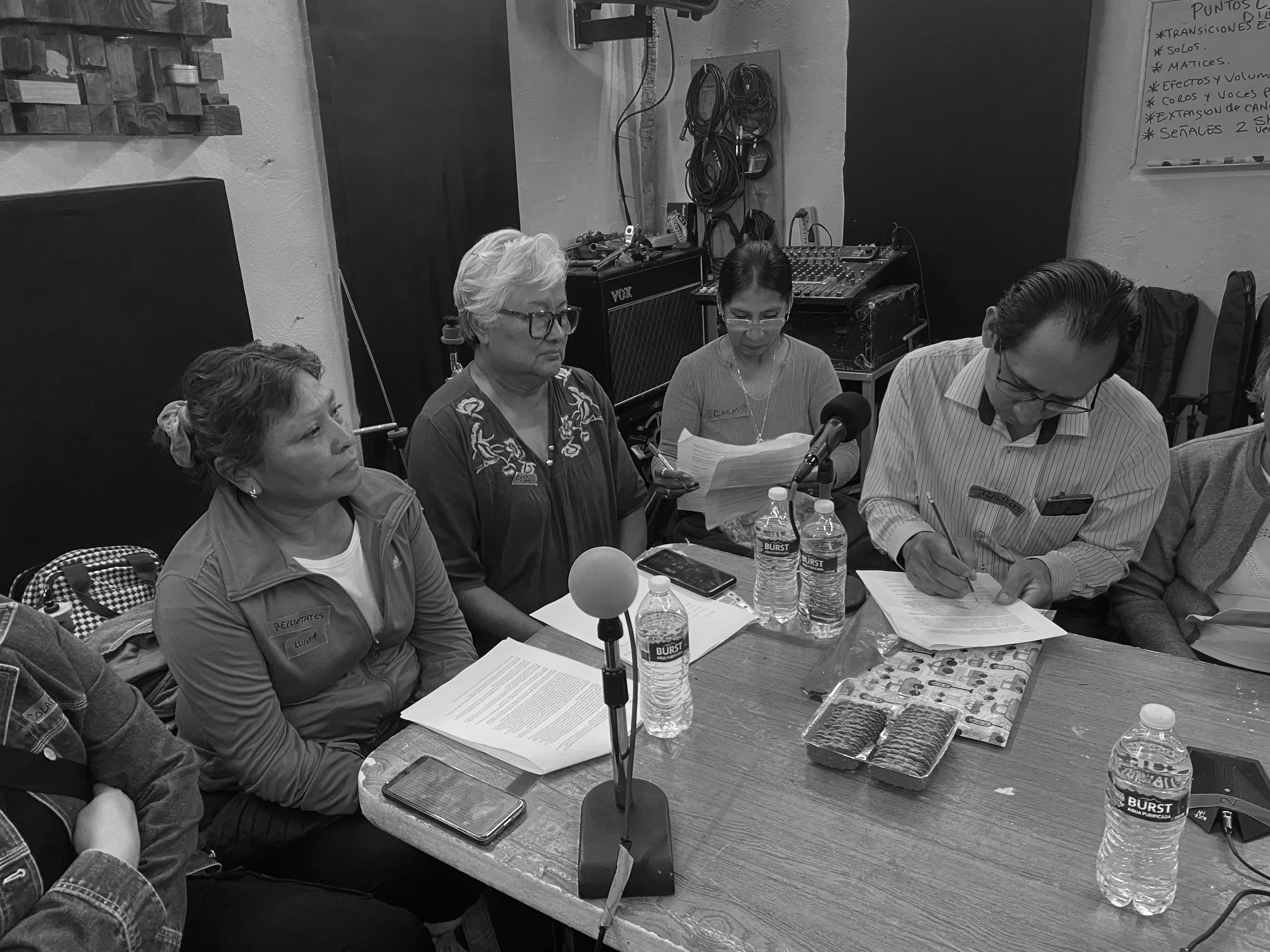An Inter-Institutional Platform
for PhDs, PostDocs and ECRs in
Architectural History and Theory,
Landscape and the City
for PhDs, PostDocs and ECRs in
Architectural History and Theory,
Landscape and the City
︎
Regular Talks
︎︎︎Online Sessions Link︎︎︎
︎
︎︎︎Online Sessions Link︎︎︎
18 November 2025
10:00 AM EST / 4:00 PM CEST
Ambition and Spectacle:
RYAN J. MITCHELL
Temple University
Respondent: TBA
![]()
Mehmed Ali receiving guests at Shubra Palace in Cairo by Pascal Coste (1787-1879) in Architecture arabe; ou, Monuments du Kaire, mesurés et dessinés, de 1818 à 1826. Image: MIT Dome.
***
CATARINA FLAKSMAN
Harvard University
Respondent: TBA
![]()
Installation photograph of brasilien baut exhibition, Zurich, Switzerland, 1954 (Museu Histórico e Diplomático / ERERIO / MRE / Mapoteca).
Between 1952 and 1960, over twenty-five exhibitions of Brazilian architecture traveled to cities around the world, from Buenos Aires to Tokyo, passing through Bogota, Lisbon, London, Zurich, Paris, Rome, Madrid, Berlin, Vienna, Brussels, and beyond. Organized by Brazil’s Ministry of Foreign Affairs, or Itamaraty, the exhibitions were part of an ambitious program to promote a modern imaginary of Brazil abroad, in turn constructing a transnational network of public and private agents and institutions. These traveling architecture exhibitions became a key instrument of cultural diplomacy, especially within the national developmentalist project that marked the presidency of Juscelino Kubitschek (1956-1961). Drawing from my ongoing dissertation, this paper investigates the international projection of Brazil’s modern architecture through a series of traveling exhibitions, shedding light on an orchestrated cultural, political, and aesthetic project of identity construction highly dependent on mechanisms of display.The investigation of these previously unstudied exhibitions suggests that architecture played a fundamental role in the cultural politics of Brazil, at home and abroad. Architecture exhibitions became a medium to construct and disseminate images and narratives aligned with the interests of the state. Based on extensive research primarily conducted in the archives of the Ministry of Foreign Affairs, the study of the exhibitions and the networks they established offers new readings of the intricate relationship between architecture, media, and politics at a time of geopolitical change during the Cold War. As a key player in Brazil’s modernization process, modern architecture was first mobilized as a tool for nation-building and, later, as part of a worldmaking project to reimagine the country’s position in the world. The display of architecture became a critical mechanism developed by the state apparatus to manifest Brazil’s anxiety to become modern, which would eventually materialize in 1960 with the construction of the country’s new capital, Brasília.
10 March 2026
10:00 AM EST / 4:00 PM CEST
![]()
The Wringin Anom Sugar Factory is one of the few remaining nineteenth-century sugar factories still operating in Java today. Originally built by a British sugar manufacturer in 1845, the factory compound once functioned not only as a centre of sugar production but also as a tool of colonial control over the surrounding population and plantation landscape. Today, the site is on the verge of ruin.
Java’s colonial sugar industry began to collapse in the 1930s and was nationalised by the Indonesian state in 1958. Once a leading global exporter of sugar, Java now imports sugar on a massive scale, with Indonesia ranking among the world’s largest importers. The physical infrastructure left behind by thecolonial sugar industry – comprising roads, housing, and plantations – has largely deteriorated, yet it continues to influence rural life and labour today. For instance, the socioeconomic systems and shifts in land ownership that were established during the colonial-industrial era of the nineteenth century continue to exist. Additionally, housing facilities for sugar factory workers, built by sugar manufacturers that introduced modern construction methods, materials, and hygiene standards to the countryside, continue to influence domestic architecture in broader Javanese rural communities today.
In this presentation, I will showcase a work-in-progress paper examining the spatial, architectural, and social legacy of the Dutch colonial sugar industry in postcolonial Java through a case study of the Wringin Anom factory compound – a workers’ village designed around notions of hierarchy, efficiency, and control, which remains inhabited today. Drawing on extensive fieldwork and a lengthy research stay in the factory’s workers’ housing facilities, the paper aims to present the spatial conditions of colonial-era housing in the postcolony. It brings to light how these environments reflect and reinforce labour hierarchies, shaping the lives and livelihoods of contemporary sugar workers in Java’s rural
landscape.
![]()
In 1851, the third failed canal project of Iskenderun to drain its centuries old marshes was laid out and executed by the Hungarian engineer General Maximilian Stein. He was one of the Hungarianrefugees who had fled the Austria- Hungarian Empire and served under the Ottoman army with the name Ferhat Pasha. Ferhat Pasha, who had previously served as the Hungarian Minister of War and Governor of Transylvania, also prepared Iskenderun’s first urban plan. Though the canal overflooded the town soon after and the urban plan was never executed, both projects reveal the interplay between the global and planetary forces, which shaped mid-19th century Iskenderun in the making.
Iskenderun was founded on a piece of land, which was formed by the sand and sediments brought by the sea and the streams flowing down the Amanus Mountains surrounding the town. Both geological phenomena were responsible for the marshes and the continuous seaward growth of the coastline. Although the marshy land of Iskenderun made it unfit for human habitation and riskedhuman life with malaria, the town was forced into being by the pressure of the global on the
planetary. Driven by the ever-increasing international trade, coupled with imperial ambitions of the British Empire to establish faster communications with India across Mesopotamia and the Ottoman Empire’s aspirations to civilize both its subjects and its land, Iskenderun witnessed a
series of failed drainage attempts throughout the 19th and first half of the 20th century. Despite its almost constant marshy state, Iskenderun gradually grew after Ferhat Pasha’s failed canal project and unrealized urban plan in 1851, fueled by the imaginary of a vibrant and prosperous port, as well as strategic stronghold to be.
This article maps out physical imprints of the 1851 canal project on Iskenderun’s land, as well as the gradual growth of the town’s built environment and its population in the 1850s. While doing so it also seeks to trace the global and empire-wide dynamics that forced Iskenderun into being.
10:00 AM EST / 4:00 PM CEST
Ambition and Spectacle:
The Architectural Patronage of Mehmed Ali Pasha of Egypt
RYAN J. MITCHELL
Temple University
Respondent: TBA

Mehmed Ali receiving guests at Shubra Palace in Cairo by Pascal Coste (1787-1879) in Architecture arabe; ou, Monuments du Kaire, mesurés et dessinés, de 1818 à 1826. Image: MIT Dome.
Mehmed Ali’s nearly forty-year reign as Ottoman governor of Egypt from 1805 until his death in 1849 profoundly transformed the province’s visual and architectural culture, which were critical tools in his modernizing initiatives that allowed Egypt to emerge as Istanbul’s primary opponent in cultural, aesthetic, and political arenas until the end of the Ottoman Empire in 1922. This talk discusses ongoing research conducted across Egypt, Greece, and Turkey that feeds a broad, comparative investigation of Mehmed Ali’s building activities in the Eastern Mediterranean. Through analysis of religious structures, palaces, industrial buildings, infrastructural projects, and institutions such as hospitals and schools, the project reconsiders definitions of center and periphery in imperial visual discourses, as well as addresses aspects of Egyptian visual culture that remain highly understudied in art historical scholarship. In addition, it contextualizes Mehmed Ali’s architectural patronage within the broader field of Ottoman architectural history in a period when much of the empire’s most dynamic building projects could be found in its provinces, often the product of powerful ayan families’ ambitions. Analyzing Mehmed Ali's patronage of such projects reveals how the governor's policies, singular will, and the socio-cultural milieu that emerged under his auspices relied heavily on visual media that allowed him to succeed in his dynasty-building ambitions.
***
Anxiety, Modernity, and Worldmaking: The Ministry of Foreign Affairs’ Traveling Exhibitions of Brazilian Architecture
CATARINA FLAKSMAN
Harvard University
Respondent: TBA

Installation photograph of brasilien baut exhibition, Zurich, Switzerland, 1954 (Museu Histórico e Diplomático / ERERIO / MRE / Mapoteca).
Between 1952 and 1960, over twenty-five exhibitions of Brazilian architecture traveled to cities around the world, from Buenos Aires to Tokyo, passing through Bogota, Lisbon, London, Zurich, Paris, Rome, Madrid, Berlin, Vienna, Brussels, and beyond. Organized by Brazil’s Ministry of Foreign Affairs, or Itamaraty, the exhibitions were part of an ambitious program to promote a modern imaginary of Brazil abroad, in turn constructing a transnational network of public and private agents and institutions. These traveling architecture exhibitions became a key instrument of cultural diplomacy, especially within the national developmentalist project that marked the presidency of Juscelino Kubitschek (1956-1961). Drawing from my ongoing dissertation, this paper investigates the international projection of Brazil’s modern architecture through a series of traveling exhibitions, shedding light on an orchestrated cultural, political, and aesthetic project of identity construction highly dependent on mechanisms of display.The investigation of these previously unstudied exhibitions suggests that architecture played a fundamental role in the cultural politics of Brazil, at home and abroad. Architecture exhibitions became a medium to construct and disseminate images and narratives aligned with the interests of the state. Based on extensive research primarily conducted in the archives of the Ministry of Foreign Affairs, the study of the exhibitions and the networks they established offers new readings of the intricate relationship between architecture, media, and politics at a time of geopolitical change during the Cold War. As a key player in Brazil’s modernization process, modern architecture was first mobilized as a tool for nation-building and, later, as part of a worldmaking project to reimagine the country’s position in the world. The display of architecture became a critical mechanism developed by the state apparatus to manifest Brazil’s anxiety to become modern, which would eventually materialize in 1960 with the construction of the country’s new capital, Brasília.
10 March 2026
10:00 AM EST / 4:00 PM CEST
Ashes to Ashes: Reading the Ruins of the Dutch Colonial Sugar Industry in Postcolonial Java
SANDRO ARMANDA
KU Leuven
Respondent: TBA
KU Leuven
Respondent: TBA

The
Wringin Anom Sugar Factory hidden behind the dense sugarcane field. Photo by
Sandro Armanda, 2025.
The Wringin Anom Sugar Factory is one of the few remaining nineteenth-century sugar factories still operating in Java today. Originally built by a British sugar manufacturer in 1845, the factory compound once functioned not only as a centre of sugar production but also as a tool of colonial control over the surrounding population and plantation landscape. Today, the site is on the verge of ruin.
Java’s colonial sugar industry began to collapse in the 1930s and was nationalised by the Indonesian state in 1958. Once a leading global exporter of sugar, Java now imports sugar on a massive scale, with Indonesia ranking among the world’s largest importers. The physical infrastructure left behind by thecolonial sugar industry – comprising roads, housing, and plantations – has largely deteriorated, yet it continues to influence rural life and labour today. For instance, the socioeconomic systems and shifts in land ownership that were established during the colonial-industrial era of the nineteenth century continue to exist. Additionally, housing facilities for sugar factory workers, built by sugar manufacturers that introduced modern construction methods, materials, and hygiene standards to the countryside, continue to influence domestic architecture in broader Javanese rural communities today.
In this presentation, I will showcase a work-in-progress paper examining the spatial, architectural, and social legacy of the Dutch colonial sugar industry in postcolonial Java through a case study of the Wringin Anom factory compound – a workers’ village designed around notions of hierarchy, efficiency, and control, which remains inhabited today. Drawing on extensive fieldwork and a lengthy research stay in the factory’s workers’ housing facilities, the paper aims to present the spatial conditions of colonial-era housing in the postcolony. It brings to light how these environments reflect and reinforce labour hierarchies, shaping the lives and livelihoods of contemporary sugar workers in Java’s rural
landscape.
***
Global Ambitions, Planetary Forces: Drainage, Urban Planning, and the Making of Iskenderun, 1851
FEYZA DALOGLU
METU, Middle East Technical University
Respondent: TBA
METU, Middle East Technical University
Respondent: TBA

In 1851, the third failed canal project of Iskenderun to drain its centuries old marshes was laid out and executed by the Hungarian engineer General Maximilian Stein. He was one of the Hungarianrefugees who had fled the Austria- Hungarian Empire and served under the Ottoman army with the name Ferhat Pasha. Ferhat Pasha, who had previously served as the Hungarian Minister of War and Governor of Transylvania, also prepared Iskenderun’s first urban plan. Though the canal overflooded the town soon after and the urban plan was never executed, both projects reveal the interplay between the global and planetary forces, which shaped mid-19th century Iskenderun in the making.
Iskenderun was founded on a piece of land, which was formed by the sand and sediments brought by the sea and the streams flowing down the Amanus Mountains surrounding the town. Both geological phenomena were responsible for the marshes and the continuous seaward growth of the coastline. Although the marshy land of Iskenderun made it unfit for human habitation and riskedhuman life with malaria, the town was forced into being by the pressure of the global on the
planetary. Driven by the ever-increasing international trade, coupled with imperial ambitions of the British Empire to establish faster communications with India across Mesopotamia and the Ottoman Empire’s aspirations to civilize both its subjects and its land, Iskenderun witnessed a
series of failed drainage attempts throughout the 19th and first half of the 20th century. Despite its almost constant marshy state, Iskenderun gradually grew after Ferhat Pasha’s failed canal project and unrealized urban plan in 1851, fueled by the imaginary of a vibrant and prosperous port, as well as strategic stronghold to be.
This article maps out physical imprints of the 1851 canal project on Iskenderun’s land, as well as the gradual growth of the town’s built environment and its population in the 1850s. While doing so it also seeks to trace the global and empire-wide dynamics that forced Iskenderun into being.
21 April 2026
10:00 AM EST / 4:00 PM CEST
Cultivating Urbanism
TITHI SANYAL
University of Virginia
Respondent: TBA
University of Virginia
Respondent: TBA
For more than 130 years, Detroit has been at the forefront of urban gardening and agricultural initiatives in the United States. While French colonists established Ribbon Farms along the Detroit River in the 1700s, modern urban agriculture in Detroit has been shaped by economic struggles, population decline, ubiquity of vacant land, and food insecurity, starting with the national economic depression of 1893–97. Today, there is widespread adoption of Agroecology- “the science, practice and movement” of conservative agriculture in the city, witnessed through the proliferation of over 2280 networked urban farms and gardens. These land-based projects are enabled by initiatives and policies like the Keep Growing Detroit’s Garden Resource Program, Urban Agricultural Ordinance (2013), and the Detroit Black Farmer Land Fund (2019), which advocate for food sovereignty, particularly within African American communities and are forming an agroecological apparatus.
This talk will discuss the forces reshaping Detroit’s identity from a post-industrial city into an Agrarian City. It will demonstrate how Actor-Network Theory can serve as a methodology to examine the history of Detroit's agroecological landscape, while also examining the motivation and agency of the actors involved in the network. It will situate Detroit’s agroecological landscape within the broader trajectory of urban agriculture, highlighting its influence on urban planning and governance since the economic depression of 1893–97. At the center of this inquiry lies the question of how actants interact and what outcomes arise from these interactions that inform urban planning, design, and governance.
This talk will discuss the forces reshaping Detroit’s identity from a post-industrial city into an Agrarian City. It will demonstrate how Actor-Network Theory can serve as a methodology to examine the history of Detroit's agroecological landscape, while also examining the motivation and agency of the actors involved in the network. It will situate Detroit’s agroecological landscape within the broader trajectory of urban agriculture, highlighting its influence on urban planning and governance since the economic depression of 1893–97. At the center of this inquiry lies the question of how actants interact and what outcomes arise from these interactions that inform urban planning, design, and governance.
***
Presence, Calibration and Failure: Spatial and Knowledge Strategies in the Co-production of Drainage Infrastructures.
ALESSIO MAZZARO
Politecnico di Torino
Respondent: TBA
Politecnico di Torino
Respondent: TBA

Workshop of Radionovela, July 2025, Colonia Culturas de Mexico.
The peripheries of Sao Paulo and Mexico City are territories where the alterations of water bodies, urban development, and the conflict between opposing interests and visions are so strong it may be impossible to conceive of a definitive solution to the problems related to water. Drawing on fieldwork experience and participatory art activities with inhabitants in two different case studies, this contribution examines the dynamics of co-producing knowledge and infrastructures through the categories of failure, presence, and calibration. The territory is approached as a stage where, in response to water management challenges, actions are rehearsed and revised—together with the public—by observing and learning from their effects.
In Torresmo (BZ), an informal settlement divided by a stream whose channelization increased the incidence of flooding, failure (of a drainage infrastructure, of state technicians and of a university laboratory) generates knowledge and materializes the forces at play in the territory. Here, through a list of doubts and questions (triggered by artistic activities) about a future lamination basin, residents engage with the Secretariat of Infrastructure (SIURB), contributing to exerting pressure and to voicing alternative ways of managing water in the territory.
In Colonia Culturas de México (MX), a settlement at the edge of the former Lake Chalco, a local collective dealing with the construction of a new wastewater pipe, participates in the making of the infrastructure: being present (Taylor 2020) with their bodies and questions in the construction site and conducting a practical inquiry (Dewey 1938). Monitoring in a Whatsapp group, water level and issues in the infrastructure elements, they participate in the calibration of the drainage infrastructure. Here, calibration, that is usually a technical/engineering procedure oriented toward a predetermined outcome, becomes epistemic and a collective process of relational adjustment (Latour 2005) among heterogeneous actors (engineers, inhabitants, infrastructural elements).
In Torresmo (BZ), an informal settlement divided by a stream whose channelization increased the incidence of flooding, failure (of a drainage infrastructure, of state technicians and of a university laboratory) generates knowledge and materializes the forces at play in the territory. Here, through a list of doubts and questions (triggered by artistic activities) about a future lamination basin, residents engage with the Secretariat of Infrastructure (SIURB), contributing to exerting pressure and to voicing alternative ways of managing water in the territory.
In Colonia Culturas de México (MX), a settlement at the edge of the former Lake Chalco, a local collective dealing with the construction of a new wastewater pipe, participates in the making of the infrastructure: being present (Taylor 2020) with their bodies and questions in the construction site and conducting a practical inquiry (Dewey 1938). Monitoring in a Whatsapp group, water level and issues in the infrastructure elements, they participate in the calibration of the drainage infrastructure. Here, calibration, that is usually a technical/engineering procedure oriented toward a predetermined outcome, becomes epistemic and a collective process of relational adjustment (Latour 2005) among heterogeneous actors (engineers, inhabitants, infrastructural elements).